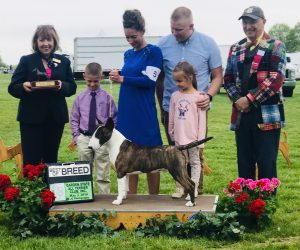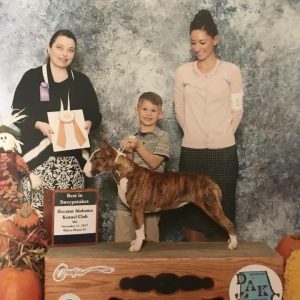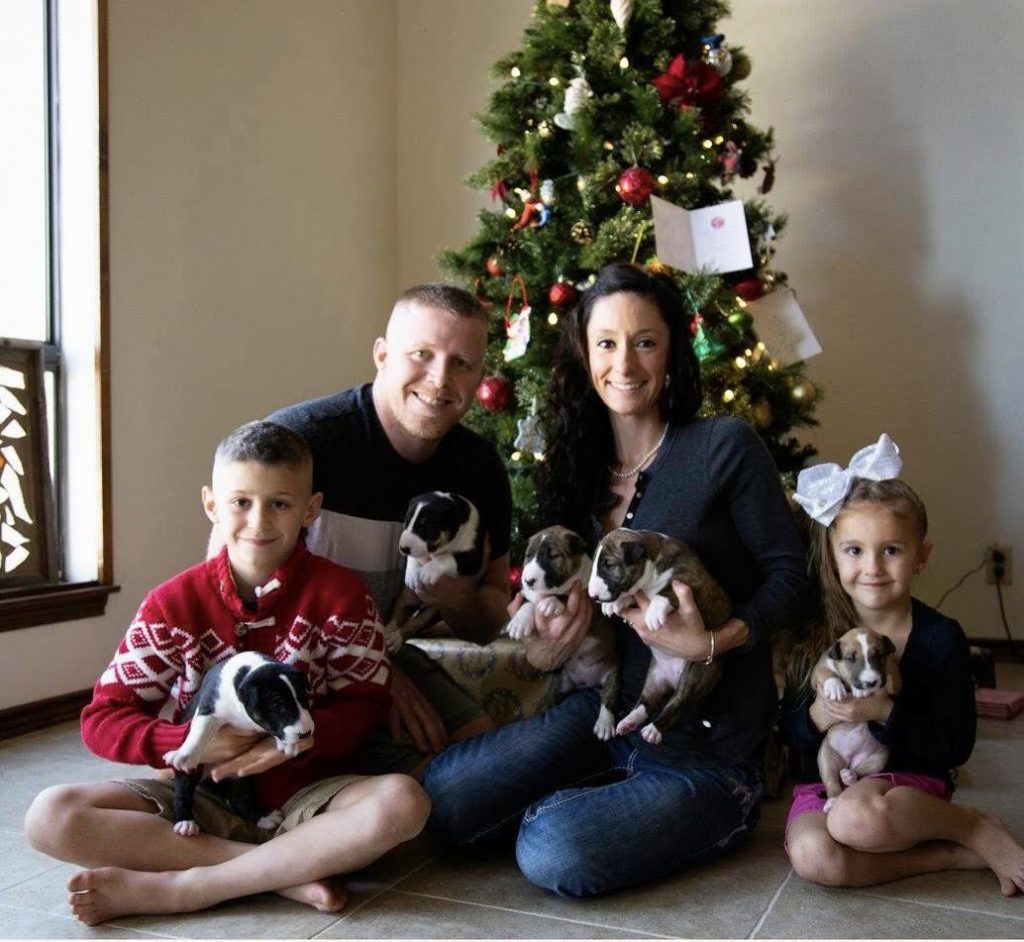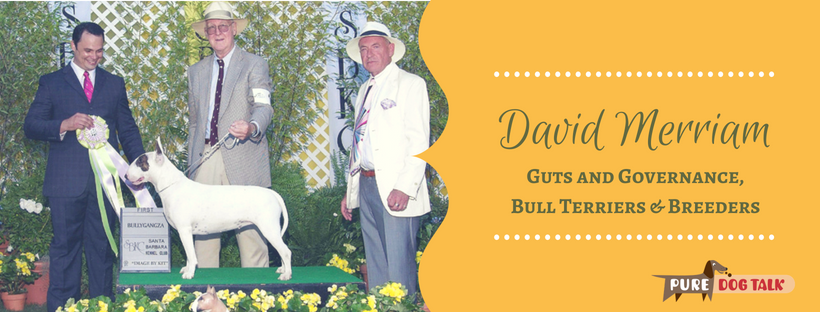377 – New Dog Breeders Offer Hope for the Future
New Dog Breeders Offer Hope for the Future
Purebred dogs need more, new, young breeders. This is the consensus opinion of our top experts in the field. Preserving our breeds and encouraging more participation in our sports requires the energy and enthusiasm of youth.
So, I reached out to the Pure Dog Talk listener community to find some of these folks. This was my conversation with Sam and Curtis Brown about the breeding program they are developing in Bull Terriers (bonus, a teaser for our “rare breeds month” in April!).
This was an outstanding conversation that gave me hope for the future. Enjoy the podcast! A couple of excerpts are below.
Continue striving for better
Curtis: “I’m the one with the puppies all day and I’m the one doing multiple C-sections by myself, which I never would have seen myself doing, and delivering puppies. So, it’s difficult in that aspect. But when it comes right down to why we continue to breed, for me there are two reasons.
“The joy on the faces of the families when we get to send companion puppies home with them has always been a remarkable thing. Companion puppies that people just love forever. Our Delicious bull terrier family of everybody to who we sent puppies follows us on Facebook and continuously posts pictures of their dogs as they grow and we get to kind of see them grow.
“You’re like ‘well maybe we should have kept that one in hindsight,’ maybe next time we’ll think of it differently before we put it in a pet home. But as we go on and as we continue to breed obviously we want to continue to breed better dogs … even if we have an amazing dog or an amazing bitch like the one who we just had win the grand futurity at our Silverwood show this past year … we still want to continue to strive to breed better dogs, not only for our breed but for the betterment of our breed. … preservation breeding, continuing to do things and enhance the breed the best that we can, not just in type but the temperaments and everything.
“So that’s why I think when we continue to breed. Not just take … that one dog and then just run it until you win Westminster … or whatever the case may be. We have to continue to create the next best thing. … we go to the Silverwood specialty show and a lot of people are showing dogs that we’ve seen in the ring many, many years over and we’re the ones there with all of these young puppies …”
Family affair

Sam: “It’s an incredible journey … you’re going to make some concessions in your personal life. Mostly sleep … but you’re also going to go all over the world you’re going to meet incredible people … we have friends that are closer than our extended family in dogs. … when you’re breeding you know you’re really doing something that’s very special. It’s not only special to you, but it’s special for those families that are going to be getting dogs from you …
 “…it’s great for kids … we do everything as a family. We go to the shows as a family. We raise the puppies as a family. We do the chores as a family. It is something that a family can do, that’s not in an agricultural area. You can raise a litter of puppies in the suburbs, it’s not a big deal … it’s something that you can sort of instill some of those 4H type lessons into your kids. We always advocate for responsible breeding … but I think it’s a positive thing and it’s definitely a family thing, at least for us, that everybody can be involved in. My kids, they’ve bottle-fed puppies and they clean up after dogs. I think that’s really important stuff when it comes to our sport. I heard Pat Trotter say at one point ‘You know it’s great to run around to get ribbons but someone’s gotta be doing the cleaning up and the breeding’ and that’s kind of where we’re at with it.”
“…it’s great for kids … we do everything as a family. We go to the shows as a family. We raise the puppies as a family. We do the chores as a family. It is something that a family can do, that’s not in an agricultural area. You can raise a litter of puppies in the suburbs, it’s not a big deal … it’s something that you can sort of instill some of those 4H type lessons into your kids. We always advocate for responsible breeding … but I think it’s a positive thing and it’s definitely a family thing, at least for us, that everybody can be involved in. My kids, they’ve bottle-fed puppies and they clean up after dogs. I think that’s really important stuff when it comes to our sport. I heard Pat Trotter say at one point ‘You know it’s great to run around to get ribbons but someone’s gotta be doing the cleaning up and the breeding’ and that’s kind of where we’re at with it.”
360 — Specialty vs All Breed Dog Shows
Specialty vs All Breed Dog Shows
In certain breeds, the judging of breed specialists and specialty shows draws higher entries and is of greater interest to the exhibitors than the day-in, day-out all-breed shows with which most of us are familiar.
In part one of this panel discussion, three exhibitors and judges from some of these breeds share their thoughts about why this is so.
“We wanted to take back ownership of our breed. Generic dogs were winning at all breed shows versus the details of breed type that breed specialist judges would reward.”
Our panelists are:
David Alexander, Bull Terrier Breeder,
Jason Nicolai, Staffordshire Bull Terrier Breeder
Marcy Fine, Collie breeder.
Bull Terriers, Staffordshire Bull Terriers, and Collies are all breeds in which specialties are the holy grail and all-breed dog shows are considered less important.
Take a listen to part one of this challenging conversation about the “why” and join us next week when we talk about the solutions. My thanks to Lorelei Craig, President of the Staffordshire Bull Terrier Club of America for arranging this panel of experts.
184 – Merriam: Guts and Governance, the Bull Terrier, Breeders
“Guts and Governance” of purebred dogs, the Bull Terrier, and Breeders
Hon. David Merriam was given a White Bull Terrier in 1953. “Gigi” was the gift that keeps on giving, starting a 65-year love affair with the breed and purebred dogs.
When Merriam was given Gigi, he had some Collies. “They were not very good collies, conformation-wise,” he said. “Then I was given this bull terrier and she won quite a bit,” he added, in regard to why he’d chosen the Bull Terrier breed. “And winning is better than losing. They grow on you. You become very chauvinistic about them.”
Judging Similarities in Court or in the Ring
Merriam was a trial court judge in Southern California for 20 years and president of the Golden State Bull Terrier Club while still in law school.
“There’s a similarity in judging law cases and dog shows,” said Merriam, who presided over Best in Show at Westminster Kennel Club in 2015. “Each has a standard. AKC has a standard for each breed. In the courts the standard is known as the law. In the courts you receive evidence… testimony or physical evidence. In a dog show the evidence is the dogs in front of you. What you see and feel and the application of the standard to those animals.”
History and Judging of Bull Terriers
The essence of the Bull Terrier is the head, Merriam noted. “It’s an egg-shaped head. It’s only commonly been found in the last 20 years or so. Heads have improved enormously. Alva Rosenberg said, ‘Close your eyes, put your hand on the head. It should feel like a velvet egg.’”
The breed was developed as the *white* bull terrier, Merriam said. “Those devoted to the White Bull Terrier thought the Colored dogs were mongrels,” he added. “It wasn’t until the late 1930s that the Colored Bull Terrier was imported to the US from England. There were huge fights within the bull terrier club and the American Kennel Club about recognition of the variety. “Colored (bull terrier) development was slow. It wasn’t until the ‘70s that the quality began to be developed,” he observed.
“It’s been a successful marriage,” Merriam said of the two varieties. He remarked on some problems associated with white bull terriers, including deafness and skin problems. Research by the BAER hearing test program showed that “(In) white to white (breedings), one-third of the litter would have some hearing deficiency. White to colored that went down to 6 percent.”
BTCA presented the information to breeders, who then found value in the Colored variety and began using them in breeding programs. “If you give competent breeders the tools and the information, they’ll help correct the situation,” Merriam said.
Guts and Governance
As a long-time AKC delegate and past Chairman of the Board of Directors, Merriam noted that the “guts” of the sport is at the level of the next dog show and the next breeding.
“The governance of it, whether in the delegate body or the Board of Directors, is of lesser interest to all the people here at the dog show,” Merriam said. “How many exhibitors or breeders read the minutes of the board meetings? They only become aware of those when a new regulation comes down.”
Calling himself a “traditionalist,” Merriam challenged some of the ideas and directions of the American Kennel Club.
“If I were king, I would divide the kennel club,” Merriam stated. “I would have the traditional part of conformation and field trials in one group and then I would have all of the other (companion events) in another group. … Each of the two organizations would have to support themselves.”
“The most important thing,” Merriam said in summary, “is that each breed has a coterie of outstanding breeders. They are what moves the breed ahead. Nothing that AKC does change that.”
We hope you enjoy this thought-provoking, challenging, and fascinating conversation with one of the legends of our sport.



